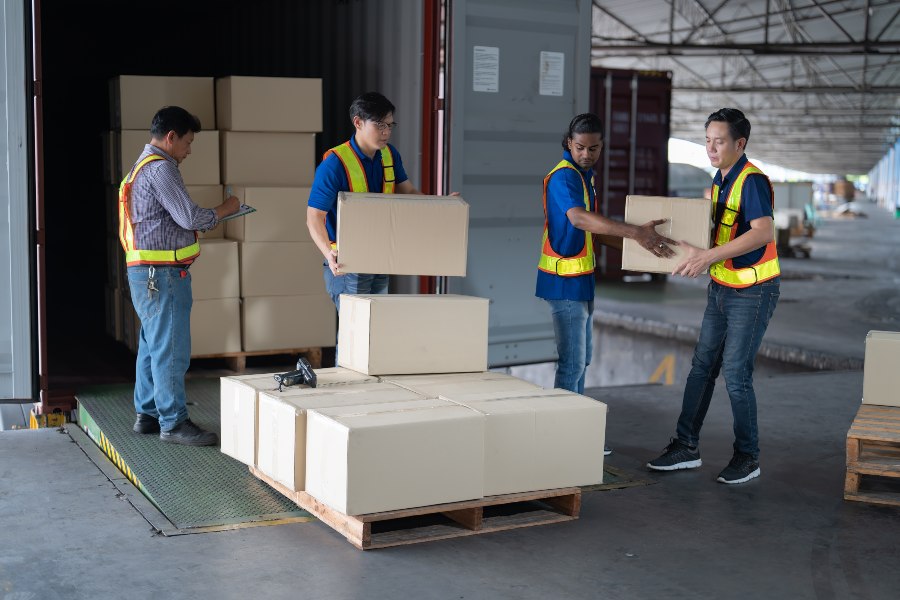Why Every Australian Needs to Know Shipping Costs Before They Click "Buy"
Shipping costs in Australia can make or break your online shopping experience, with unexpected fees turning what seemed like a bargain into an expensive mistake. Whether you're a customer hunting for the best delivery deals or a business owner trying to balance affordable shipping rates with profitable margins, understanding the true cost of getting packages from point A to point B has never been more critical.
With ecommerce booming and customers increasingly price-sensitive, every dollar spent on shipping matters - and the difference between choosing the right and wrong shipping service can save you hundreds over time.
The Real Cost Drivers Behind Every Australian Shipment
Understanding Weight, Size, and Distance - The Factors That Determine Your Final Cost
When it comes to shipping cost calculations, three primary factors determine what you'll pay: weight, dimensions, and destination. Australian carriers charge whichever is higher: actual weight or cubic (volumetric) weight. Australia Post's cubic weight formula is: Length (m) × Width (m) × Height (m) × 250. For example, a parcel measuring 0.5m × 0.3m × 0.4m = 0.06m³ × 250 = 15kg cubic weight.
Example: 40 × 30 × 20 cm = 24,000 cm³ → 24,000 ÷ 6,000 = 4.0 kg cubic, so a 200g cushion is charged as 4kg.
For Australia Post, flat national rates apply up to 5kg (same price anywhere in Australia for those weights). Over 5kg, pricing becomes zone-based by destination.
Distance plays an equally crucial role in cost structure calculations. Shipping within metro areas like Sydney to Melbourne typically costs less than sending the same package to regional Queensland or remote Western Australia. Australia Post and other major couriers maintain detailed zone maps that vary depending on your origin and destination postcodes, with some remote areas attracting surcharges that can double standard shipping rates.
Service levels create another layer of pricing complexity. Express Post offers next business day delivery within the Express Post network, which covers approximately 80% of Australian addresses, primarily between capital cities (excluding Darwin, and for Perth, delivery into the CBD only). Service is subject to posting before cutoff times and meeting all service conditions.
Why Choose One Carrier When You Can Access 100+?
Our cloud fulfilment platform gives you instant access to over 100 carriers globally, automatically selecting the most cost-effective option for every shipment. Contact us today - (02) 9090 4747
Australia Post vs Private Couriers - When to Choose Reliability Over Speed
Comparing Cost Structure and Delivery Performance Across Major Australian Carriers
Australia Post does deliver to PO Boxes and Parcel Lockers; many private couriers do not deliver to PO Boxes (e.g., Aramex explicitly doesn't). Their flat rate shipping options, particularly prepaid satchels, provide predictable costs for businesses and customers who ship regularly.
However, private couriers like Sendle, CouriersPlease, and Aramex frequently undercut Australia Post on price, especially for metro-to-metro deliveries. 2025 Australia Post retail prices (1 July 2025):
Private couriers use quote-based pricing that varies by lane, surcharges and account tier. Sendle's Price Guarantee promises domestic rates lower than Australia Post's standard Parcel Post for comparable weights/zones.
Tracking & cover: Australia Post states most services include up to $100 compensation for loss/damage (Extra Cover available for higher values). The choice between Australia Post and private couriers often comes down to your specific needs. If you're shipping to regional areas or need PO box delivery, Australia Post's extensive network makes it the logical choice. For business customers shipping high volumes within major cities, private couriers can save substantial amounts while often providing superior tracking and customer service.
International Shipping from Australia - Premium Speed vs Budget-Friendly Options

Breaking Down Costs for Major International Carriers
International shipping costs vary dramatically depending on your chosen carrier and service level. US service changes: On 26 August 2025, Australia Post temporarily suspended US-bound parcels following changes to US de-minimis/duty rules; the situation has evolved; check Australia Post's service updates before committing to US timeframes.
Price reality check (1kg Sydney→New York): Australia Post's International Standard to Zone 3 (US & Canada) is $42.20 using your own packaging; Express is +$17 at each weight point (so $59.20 for 1kg). Transit guides are 6–10 business days (Standard) and faster for Express. Use calculators for live quotes and any surcharges.
DHL Express - Premium Speed and Reliability
DHL Express offers 2-4 business-day delivery to most global destinations. Pricing varies by route, weight, and surcharges - use DHL's shipping calculator for accurate quotes, as published retail ranges can differ significantly based on fuel and remote-area surcharges.
Their shipping calculator provides instant estimates and includes customs handling, making the process straightforward for businesses and individuals alike. With excellent tracking quality and dedicated customer support, DHL justifies its premium pricing through superior service reliability. Published retail ranges vary by lane, fuel & remote-area surcharges; reference DHL's calculator and surcharge pages for current totals.
UPS International - Zone-Based Pricing with Corporate Focus
UPS operates with a zone-based pricing system that can make costs complex to calculate without their online tools. UPS surcharge update (2025): UPS introduced an International Processing Fee of USD $2.50 per shipment (or local currency equivalent) for US-bound imports, effective 8 September 2025, applied to selected Worldwide Express services. Factor this into landed-cost comparisons. UPS positions itself between premium and economy options with strong business-focused services.
Australia Post International - Government Reliability at Moderate Prices
Australia Post's international services offer a budget-friendly alternative, with their International Standard service costing around $56 for the same Sydney to New York route, though delivery takes 6-10 business days. They don't provide customs pre-clearance, which can lead to delays, but keeps costs lower. Their extensive domestic network makes them ideal for customers who prefer dealing with a familiar, government-backed service.
Budget Alternatives - Sendle and Economy Options
For cost-conscious senders, alternative services can provide affordable international shipping, though delivery timeframes typically extend to 10-16 business days with basic tracking. These options work well for non-urgent shipments where price takes priority over delivery speed, making them popular with small ecommerce businesses and individual sellers. Rather than fixed dollar claims, reference each carrier's calculator and surcharge pages for current totals.
Understanding surcharges is crucial for accurate cost estimates. Expect monthly fuel surcharges (Australia Post, DHL, UPS) and remote/extended-area fees on express networks. These can materially change the checkout total; always check the carrier's current surcharge page. DHL and UPS both provide detailed breakdowns of these additional costs in their shipping calculators, helping you estimate the true final cost before committing to a shipment.
From Local to Global: End-to-End Logistics That Scale
Our end-to-end logistics solutions handle everything from inventory forecasting to customs clearance. Get in touch with us today - (02) 9090 4747
Smart Shopping Strategies - Timing, Consolidation, and Alternative Delivery Options
How Savvy Customers Save Money on Shipping Costs
Smart shipping strategies can save substantial amounts over time. Here are the most effective methods to reduce your shipping expenses:
- Package Consolidation - Combine multiple purchases into a single shipment rather than paying separate shipping fees for each item. Many international retailers offer this service, and third-party consolidation services can combine purchases from different stores, often saving 30-50% on international shipping costs.
- Strategic Timing Around Promotions - Time promos & thresholds: "Australia Post offers 800+ free 24/7 Parcel Lockers nationally and 4,800+ collection points. Use sales events to bundle orders to the threshold. Planning purchases to reach these minimums often proves more economical than paying individual shipping fees.
- Click-and-Collect Services - Eliminate shipping costs entirely while providing flexibility for pickup times. Australia Post offers 800+ free 24/7 Parcel Lockers nationally and 4,800+ collection points for pickup; useful to avoid delivery fees and missed-delivery costs. Many retailers now offer pickup from their physical stores or partner locations.
- Mail Forwarding for International Shopping - For frequent international shoppers, mail forwarding services provide overseas addresses for purchases, then consolidate and ship items to Australia in bulk, typically reducing per-item shipping costs by 30-50% compared to individual international shipping fees.
- Optimise Service Level Selection - Understanding different shipping options within each carrier's range helps optimise costs. Express post might cost double standard rates, but could be worth it for time-sensitive items, while economy options work perfectly for non-urgent purchases where delivery speed doesn't matter.
- Bulk Purchase Planning - Rather than making multiple small orders throughout the month, plan larger purchases that qualify for volume discounts or free shipping thresholds, reducing the per-item shipping cost across your total spend.
Business Shipping Mastery - Scaling Operations Without Breaking the Bank

Negotiating Rates, Choosing Partners, and Automating Your Logistics
Businesses shipping regularly have more room to negotiate better shipping rates and access volume discounts unavailable to individual customers. Here are the key strategies for scaling your shipping operations cost-effectively:
- Volume Discount Negotiations - Most major couriers offer business accounts with preferential pricing once monthly volumes exceed 50-100 parcels. Having shipment details and volume data readily available strengthens your negotiating position, and carriers will often match competitors' pricing to secure long-term contracts.
- Shipping Software Automation - Solutions like ShipStation, Starshipit, and Shippit can automate much of the shipping process while providing access to discounted rates across multiple carriers. These platforms integrate with ecommerce stores, automatically calculate the most cost-effective shipping method for each order, and generate labels in bulk to save time and reduce errors.
- Self-Fulfilment vs 3PL Decision - The choice between self-fulfilment and third-party logistics (3PL) depends on order volume and business model. Self-fulfilment provides complete control and works well for smaller businesses, but 3PL services often offer better shipping rates and faster delivery times once volumes justify the additional costs.
- Packaging Optimisation Programs - Using appropriately sized boxes and lightweight materials reduces both dimensional weight charges and material costs. Businesses should regularly audit their packaging to identify opportunities for improvement, as this represents a significant opportunity for ongoing cost savings.
- Multi-Carrier Strategy - Rather than relying on a single provider, maintain relationships with multiple carriers to leverage competitive pricing and ensure backup options during peak periods or service disruptions. This approach provides negotiating leverage and operational flexibility.
- Peak Period Planning - The fourth quarter typically sees increased shipping costs and potential delays, so businesses benefit from advance planning and possibly securing guaranteed capacity with preferred carriers. Early preparation helps avoid surge pricing and capacity constraints that can significantly impact costs.
Ready to Automate Your Shipping Decisions?
You've learned the cost comparison strategies - now let our shipping platform do the work for you. Check our competitive shipping pricing and give us a call now - (02) 9090 4747
Navigate Shipping Costs Like a Pro - Your Action Plan for Smarter Decisions
Understanding shipping costs empowers better decision-making, whether you're an individual customer or a growing business. The key lies in matching your specific needs, delivery speed, destination type, package characteristics, and budget constraints with the most appropriate carrier and service level.
For regular shippers, investing time in understanding each carrier's cost structure pays dividends through better choices and potential savings. Use shipping calculators to compare options before committing, and don't assume the cheapest quote represents the best value when factoring in delivery reliability and customer service quality. Consider whether you need a signature on delivery, insurance for valuable items, or assistance with customs documentation when shipping to another country.
Businesses ready to optimise their shipping operations should start by analysing current spending patterns, identifying opportunities for consolidation or automation, and exploring volume discounts with multiple carriers. The shipping landscape continues evolving, with new services and pricing models regularly emerging. Your team's ability to adapt instantly to changing postage rates and service offerings will determine long-term success. Keep detailed logs of shipment performance to identify patterns and make sense of which carriers consistently deliver value.
The difference between smart and wasteful shipping decisions compounds over time. Whether you're saving a few dollars per package as a frequent online shopper or thousands annually as a business owner, understanding and applying these principles will improve your bottom line while ensuring your packages arrive safely and on time. Light items may benefit from flat-rate packaging, while businesses managing stock levels need reliable delivery windows to maintain customer satisfaction.
Ready to transform your shipping strategy from costly guesswork to calculated precision? This article has provided the framework for making informed shipping decisions across Australia and internationally. Start by implementing these insights on your next shipment, and discover how informed shipping decisions translate into real savings and improved customer experiences.
